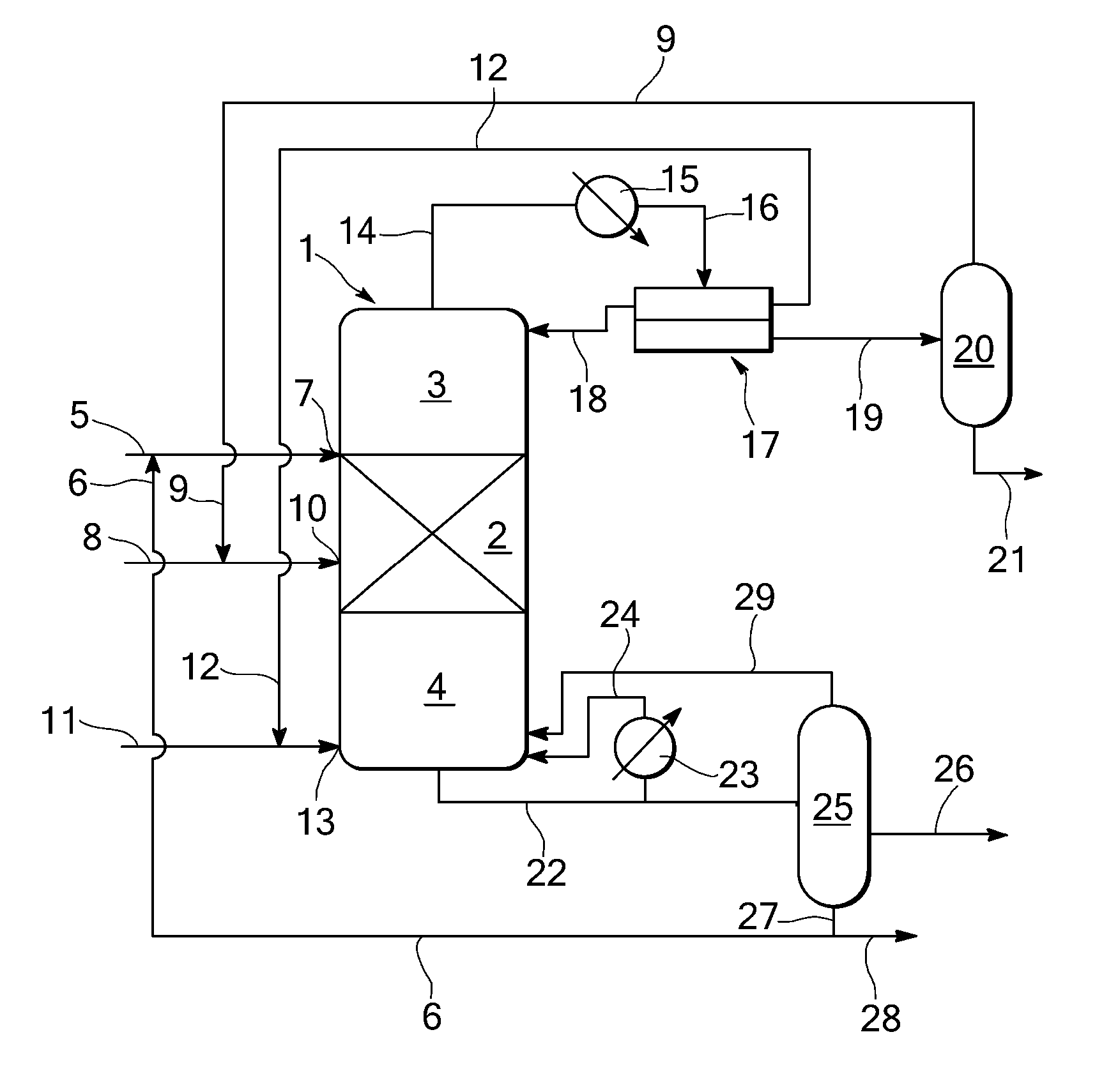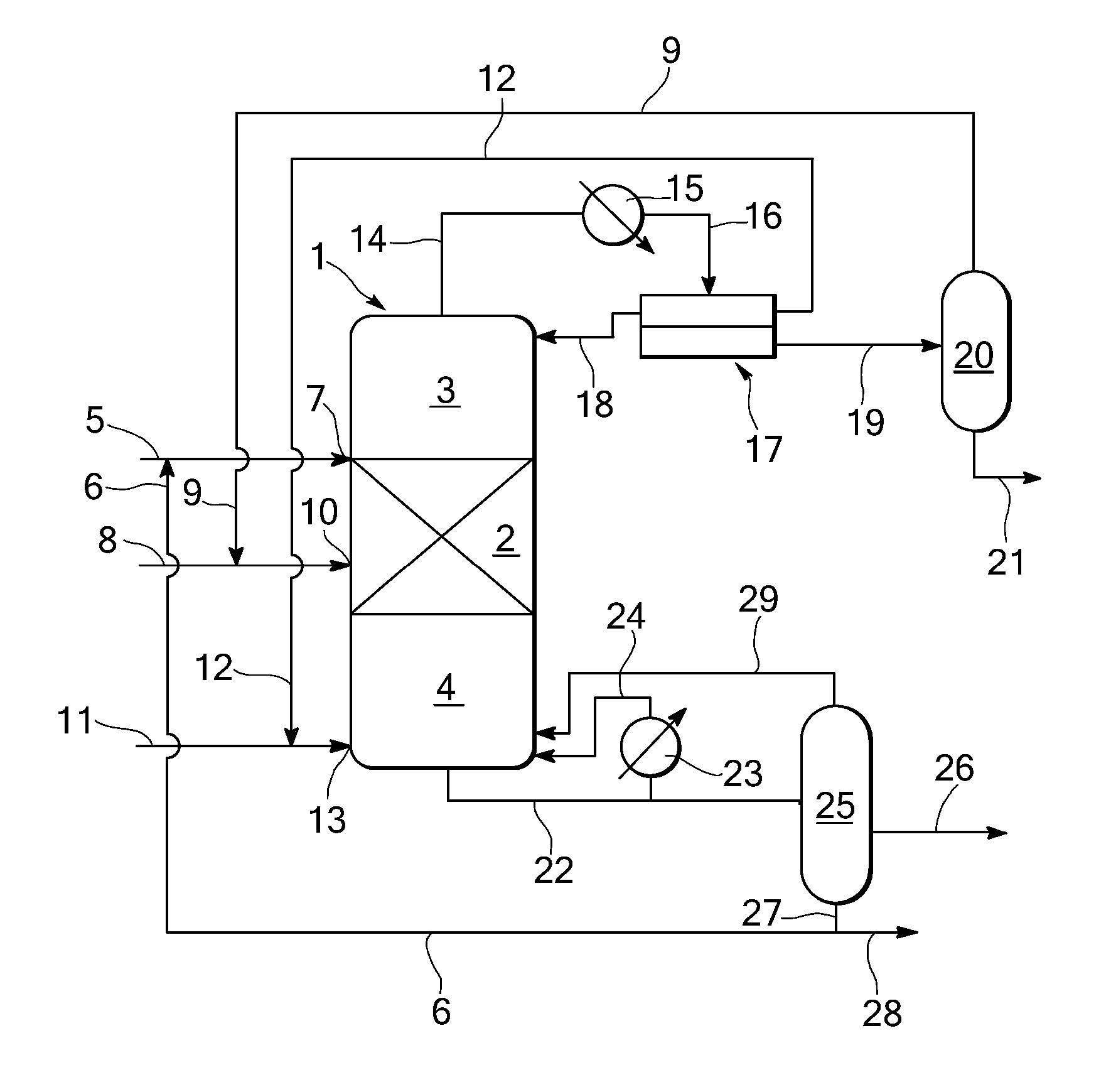Process for reactive distillation of a carboxylic acid
a technology of reactive distillation and carboxylic acid, which is applied in the direction of separation processes, organic chemistry, chemistry apparatus and processes, etc., to achieve the effect of reducing the volume of recycle streams, reducing the total energy requirement, and increasing the conversion rate of carboxylic acid
- Summary
- Abstract
- Description
- Claims
- Application Information
AI Technical Summary
Benefits of technology
Problems solved by technology
Method used
Image
Examples
example 1
No Entrainer; not According to the Invention
[0039]A reactive distillation is carried out in a distillation column with a diameter of 2.7 m, having 35 theoretical separation stages including a reaction section containing a bed (height of bed: 2.5 m) of heterogeneous esterification catalyst (Amberlyst 15 immobilised in a Sulzer Katapak-SP packing) having 10 theoretical separation stages (11th to 20th stage) and 215 kg catalyst per stage, a rectifying section above the reaction section (1st to 10th stage) and a stripping section below the reaction section having (21st to 35th stage).
[0040]A first supply stream comprising levulinic acid of 13,214 kg / h (10,440 kg / h make-up stream comprising 98 wt % levulinic acid and 2 wt % water and 2,774 kg / h recycle stream) is supplied to the column at the stage above the reaction section, i.e. at the 10th stage. A second supply stream comprising 95.4 wt % ethanol and 4.6 wt % water of 15,127 kg / h (a make-up stream of 3848 kg / h and a recycle stream of...
example 2
Entrainer Supplied to Top of Reaction Section; Not According to the Invention
[0043]In a reactive distillation column as described in EXAMPLE 1, wet ethanol is fed to the column one stage below the bottom stage of the reaction section, i.e. at the 21st stage. Levulinic acid and entrainer (cyclohexane) are fed to the stage directly above the top stage of the reaction section, i.e. at the 10th stage.
[0044]In the reaction section, esterification takes place. A top stream comprising cyclohexane, ethanol and water is obtained and a bottom stream comprising ethyllevulinate, unconverted levulinic acid, ethanol, and heavy products is obtained.
[0045]The top stream is condensed and fed to a decanter to obtain cyclohexane and a water / ethanol mixture. Thirty percent of the cyclohexane is refluxed to the top stage of the reactive distillation column and the remainder is recycled to the reactive distillation column at the 10th stage. The water / ethanol mixture is separated in a water separation col...
example 3
Entrainer to the Bottom of the Column; According to the Invention
[0048]In a reactive distillation column as described above in EXAMPLE 1 or 2 and as shown in the FIGURE, wet ethanol is fed to the reaction section at the 15th stage. Levulinic acid is fed to the column at the stage directly above the top stage of the reaction section, i.e. at the 10th stage. Entrainer (cyclohexane) is fed stage directly above the bottom stage of the column, i.e. at the 34th stage.
[0049]In the reaction section, esterification takes place. A top stream comprising cyclohexane, ethanol and water is obtained and a bottom stream comprising ethyllevulinate, unconverted levulinic acid, ethanol, cyclohexane and heavy products.
[0050]The top stream is condensed and fed to a decanter to obtain cyclohexane and a water / ethanol mixture. Thirty percent of the cyclohexane is refluxed to the top stage of the reactive distillation column and the remainder is recycled to the reactive distillation column and supplied to i...
PUM
| Property | Measurement | Unit |
|---|---|---|
| molar ratio | aaaaa | aaaaa |
| molar ratio | aaaaa | aaaaa |
| molar ratio | aaaaa | aaaaa |
Abstract
Description
Claims
Application Information
 Login to View More
Login to View More - R&D
- Intellectual Property
- Life Sciences
- Materials
- Tech Scout
- Unparalleled Data Quality
- Higher Quality Content
- 60% Fewer Hallucinations
Browse by: Latest US Patents, China's latest patents, Technical Efficacy Thesaurus, Application Domain, Technology Topic, Popular Technical Reports.
© 2025 PatSnap. All rights reserved.Legal|Privacy policy|Modern Slavery Act Transparency Statement|Sitemap|About US| Contact US: help@patsnap.com


